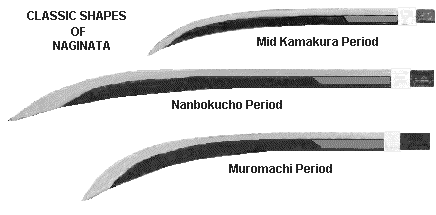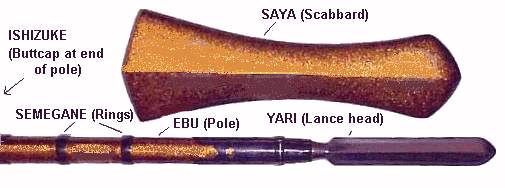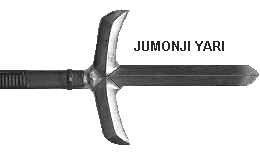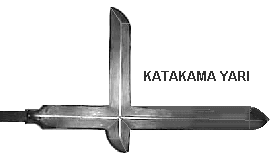 JAPANESE POLEARMS
JAPANESE POLEARMS

 JAPANESE POLEARMS
JAPANESE POLEARMS


The naginata was a common polearm used throughout Japanese history. The forging, construction and polishing is similar to that of the Japanese sword. Naginata have poles of approximately 6 feet (2 meters) in length. While naginata were used by samurai, the traditional use of the naginata was by samurai women in defending the castle during the absence of the men.
Early naginata were large with blade lengths from 1 foot to approximately 2.5 feet, highly curved with much "sori" and were quite wide. Later naginata tend to be both shorter, smaller and have less sori. Naginata may or may not be signed by the maker on nagako (tang). Not all naginata will have the pole wrapped (san-dan-maki), but all will have some type of pole reinforcement, commonly brass or copper collars and rings (semegane). The poles were normally lacquered and some may be inlayed with mother-of-pearl chips. Naginata blades were occassionally cut down, reshaped and repolished to make shobu-zukuri or unokubi-zukuri style wakizashi. Tsuba on naginata are normally very small, being essentially the same diameter as the seppa. However, some naginata had tsuba of the same size and design as those found on swords. The nakago of a naginata is secured into the pole by a single mekugi (peg), although some nakago will have two nakago-ana.

Naginata with blades similar to katana which were mounted on short poles (circa 3-4 feet) are termed nagamaki-naoshi. Nagamaki may have a yokote like a katana; naginata do not. Nagamaki were used primarily during the Kamakura and early Muromachi eras.


Yari are Japanese spears (lances) which were NOT generally intended to be thrown. Yari have been used since the earliest times. Some were made by swordsmiths and have construction similar to swords while others were made by less skilled craftsman and are of one-piece construction and may be un-tempered; i.e., have no hamon. Yari were used by both samurai and by the common foot soldier (ashigaru).
There are numerous styles of yari. The two major types are su yari (those with straight blades) and kama yari (those with horizontal crossbars on the blade). Exceptionally long su yari are termed omi no yari. If the crossbars of a kama yari are of equal length it is called a jumonji yari. A katakama yari has a single sided crossbar or crossbars of unequal length. It has been speculated that katakama yari are the result of a repair of a broken sidearm on a yumonji yari. Some yari were made with sockets which fitted over the end of a pole rather than a long nakago which slid into the pole, such socketed yari are termed fukuro yari. Jumonji yari and katakama yari pose exceptional challanges for both the swordsmith and the sword polisher.



Kikuchi yari (quite rare) are single edged and normally either kira zukuri or shobu zukuri in style. This style of yari was named for the Kikuchi family of Higo during the Nambokucho era (1336-1392). Kikuchi yari look like tanto on long poles. Yari blades may range from approximately 6 inches to well over 2 feet in length. Yari poles range from 6 feet to 8 feet in length. The poles are usually lacquered and may have mother-of-pearl inlay.
|
Gendai | Jumei Tosho | Origami | Flaws | Polearms | Tsuba | Logos | Real? | Clubs | Books | Events | Listservs | Kanji | Sageo Nakirishi Mei | Measure | NBTHK | FAQ | Sinclaire | Articles | Sword Sites | Japan Sites | Martial Arts | World Swords Yoshichika | Kanefusa | Kanezane | Teruhide | Koa Isshin | Nagamitsu | Emura | Tanto | Yoshimichi | Yasunori | Shigetsugu |